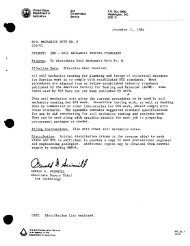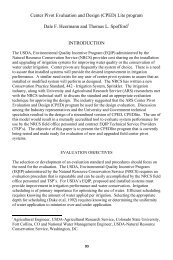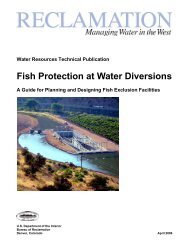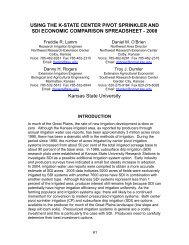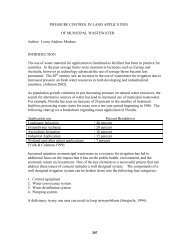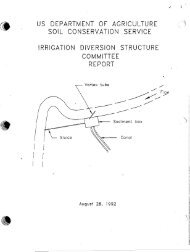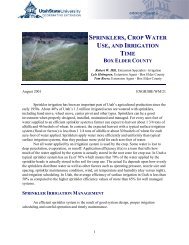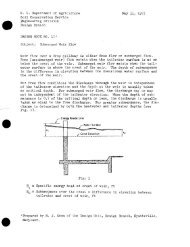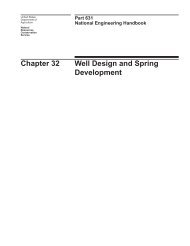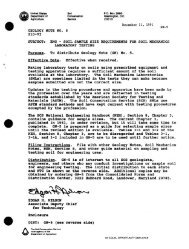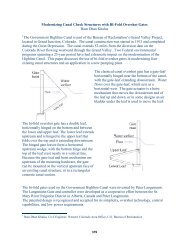NEH 16 Chapter 1 - NRCS Irrigation ToolBox Home Page
NEH 16 Chapter 1 - NRCS Irrigation ToolBox Home Page
NEH 16 Chapter 1 - NRCS Irrigation ToolBox Home Page
You also want an ePaper? Increase the reach of your titles
YUMPU automatically turns print PDFs into web optimized ePapers that Google loves.
This equation may be used to estimate the quantity of flow in simple drainageproblems, such as might be found in hillside interception over a sloping, impermeablelayer. In more complex flow problems, both the hydraulic gradient andthe hydraulic conductivity vary throughout the flow region and analysis is moredifficult. Also, the boundaries of flow may be difficult to determine. Forthese problems, it usually is impractical to define completely the area, p-ermeability,and hydraulic gradient, so less direct methods of estimating flow areemployed. These are discussed in <strong>Chapter</strong> 4, Subsurface Drainage.Sink formation in subsurface drainageSubsurface drainage is accomplished by placing below the water table an artificialchannel in which the hydraulic head is less than it is in the soil to be drained.Thus a hydraulic gradient toward the channel is induced, and a "sink" is creatkd.The sink is maintained, of course, by removing water from the artificial channelby gravity or by pumping.Two factors determine the rate at which water moves toward the sink at any point:The hydraulic gradient and the hydraulic conductivity. This is in accord withDarcy's Law. Total flow to the sink involves hydraulic conductivity throughoutthe whole soil mass through which water moves to the sink. The flow net delineatesthe extent and pattern of flow throughout this soil mass, as discussed onthe preceding pages.The desired control of the water table is accomplished (a) by locating the sinkvertically and horizontally so as to take advantage of the more permeable soilmasses, and (b) by controlling the hydraulic gradient. Hydraulic gradient maybe controlled through depth of the sink, spacing of the sinks, and (in methodsof drainage) the pressure at the sink. In Equation 1-1Hydraulic gradient =P(++zl)P- ($ + z,)these three controls affect Z2, L and P2, respectively.LDrainage devices that are used'to form sinks are buried drains, ditches, reliefwells (upward flow), vertical drains (downward flow), and pumped wells. Thehydraulic head in buried drains and in ditches depends on the water-surface elevationbecause the water is at atmospheric pressure. Relief wells, at theirlower ends where the sink usually is formed, operate under a pressure dependenton the elevation of their outlets--or of the water surface in the drain intowhich they discharge, if submerged. Pumped wells create sinks which may beeither at atmospheric pressure or above atmospheric pressure, depending on thesoil stratification and whether the sink in question is above or below the waterlevel in the pumping well.Theories of Buried Drain and Open Ditch Subsurface DrainageWater movement in the saturated zone may be analyzed by applying Darcy's Law tothe particular set of boundary conditions at the drainage-problem site. If itwere possible by field surveys to determine the exact location of impermeablelayers, the location and hydraulic head of all inflow to and outflow from thesystem, permeability in all parts of the system, time and rate of changes in flow,symmetry of the system--all the factors which affect the amount and pattern offlow--then the problem would be completely defined and subject to direct andexact solution.



